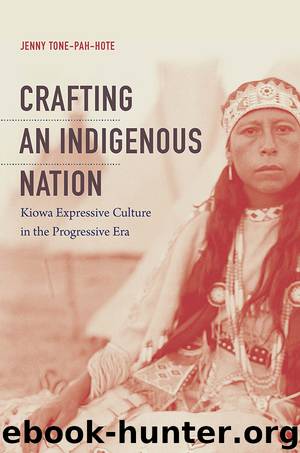Crafting an Indigenous Nation by Tone-Pah-Hote Jenny;

Author:Tone-Pah-Hote, Jenny;
Language: eng
Format: epub
Publisher: University of North Carolina Press
FIGURE 10 Jack Hokeah, Hummingbird Dance (1929, pochoir print). National Anthropological Archives, Smithsonian Institution, NAA INV 09064700.
A couple of the Gallup evening programs include a list of dances that Kiowa performers did, along with those of other tribes. The 1933 program lists a performance of the “Kiowa Eagle Dance, Kiowa Shield Dance, Kiowa Butterfly Dance, Comanche Fire Dance.”100 In 1937 Kiowa dancers put on a lively show that included the brush dance, a dance rooted in the physical preparation of the lodge where the annual ceremony occurred. They also did the “ball-kicking dance, war dances, humming bird dance, and flute solos.”101 It is clear that for these dancers, performing a mix of traditional dances like the brush dance and contemporary dances like the men’s fancy dance was acceptable. This combining of modern and traditional in music and song is also paralleled in the subject matter of the works the Kiowa artists created. In some ways viewing the dance performances was analogous to seeing the works of art they featured.
The Kiowa saw themselves as the highlight of the entire event, and they illustrated that. This image was further entrenched by the fact that men occupied the space of the subject in these works. The way these performances were built centered on dances that were done mostly by men. Their dances and paintings featured men bearing the image of the Kiowa as a nation over time. In this event, they also reproduced images for both a tourist and a fine art market in ways that made the Kiowa unique.
In “Kiowa Tinsel Cheep [sic] Stuff according to John Sloan,” an anonymous author interviewed a disgruntled John Sloan, an artist and art patron who summered in Santa Fe. Sloan and others were ignorant of the deeply traditional roots of Southern Plains powwow dancing, which was still new at that time. Sloan thought the Kiowa had acculturated and further critiqued the dance performance and the dance regalia by stating, “I could get the same effect by plucking a chicken[,] smearing it with some bluing, coating it with glue and tossing it into a barrel of feathers.”102 In fact, the reporter further noted, “Mr. Sloan’s ire was directed at the apparent aping of professional stage antics by the dancers. He was indignant that ‘this cheapness’ should be allowed to supplant ‘real color and emotional dance.’ ”103 The reporter further explained that Sloan enjoyed the Navajo and Pueblo dances. Interestingly, the troupes from these tribes were reported to have mocked Kiowa moves while on stage.104 Sloan feared this mockery would lead to war dancing.
Sloan did not fear war dancing so much as he feared cultural change in the Navajo, Pueblo, and Hopi communities, which many Anglos saw as the paragons of ancient and spiritual Native culture. John Sloan clearly did not live in the world of contemporary American Indian powwow culture. Why else would he spurn what was no doubt some of Oklahoma’s finest war and fancy dancing? For their performances in Gallup, the Kiowa performed not only the more traditional dances but also what was avant-garde in Indian country at the time.
Download
This site does not store any files on its server. We only index and link to content provided by other sites. Please contact the content providers to delete copyright contents if any and email us, we'll remove relevant links or contents immediately.
| Beadwork | Jewelry |
| Rock & Gem Crafts |
On Writing A Memoir of the Craft by Stephen King(4866)
The Doodle Revolution by Sunni Brown(4691)
A Simplified Life by Emily Ley(4102)
Mummy Knew by Lisa James(3637)
Marijuana Grower's Handbook by Ed Rosenthal(3627)
Better Homes and Gardens New Cookbook by Better Homes & Gardens(3531)
Figure Drawing for Artists by Steve Huston(3385)
Paper Parties by Erin Hung(3374)
Draw Your Day by Samantha Dion Baker(3294)
The Genius of Japanese Carpentry by Azby Brown(3228)
Japanese Design by Patricia J. Graham(3113)
The Code Book by Simon Singh(3079)
Dangerous Girls by Haas Abigail(2983)
Lions and Lace by Meagan Mckinney(2926)
The Curated Closet by Anuschka Rees(2917)
How to Make Your Own Soap by Sally Hornsey(2838)
The Checklist Manifesto by Atul Gawande(2784)
The Wardrobe Wakeup by Lois Joy Johnson(2734)
Zero to Make by David Lang(2728)
